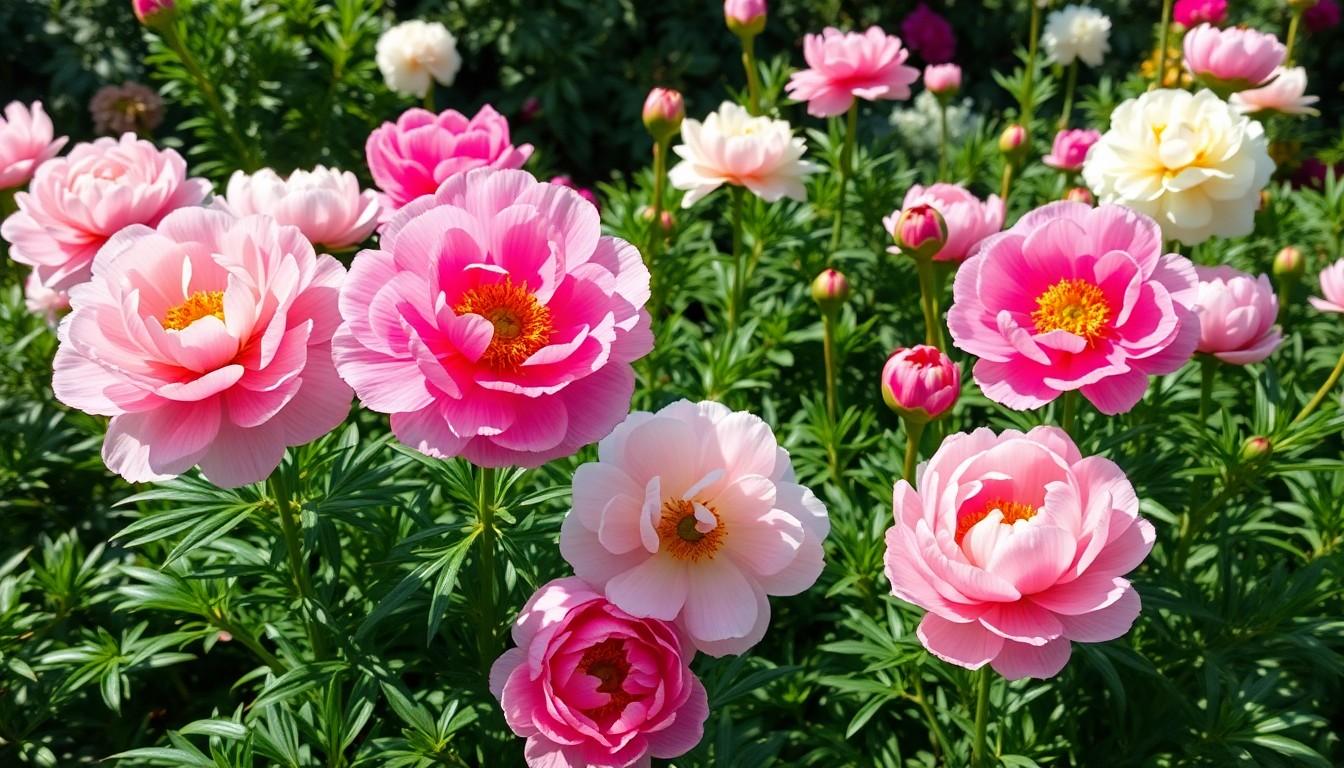Peonies are the divas of the garden world, strutting their ruffled petals and vibrant colors like they own the place. If you’ve ever daydreamed about transforming your outdoor space into a floral paradise, peonies are your ticket to a blooming good time. With their lush blooms and intoxicating fragrance, these beauties can turn any garden into a showstopper that even the neighbors will envy.
Peony Garden Design Ideas
Peonies offer diverse design possibilities in gardens. Utilizing various colors enhances visual appeal, creating spectacular combinations. Pink, white, and coral tones pair well with other flowering plants and foliage. Grouping plants in clusters instead of single specimens promotes unity and drama.
Incorporating peonies along pathways draws attention and invites exploration. Planting taller varieties at the back of borders adds depth. Integrating lower-growing plants in front creates layers and showcases the peony’s beauty. Including companion plants like delphiniums or irises complements their lavish blooms.
Positioning peonies in sunny spots maximizes growth and health. Well-drained soil ensures plants thrive without issues. Adding mulch retains moisture and suppresses weeds, aiding peony maintenance. Strategic spacing between plants fosters good air circulation, reducing disease risk.
Using peonies in container gardens allows for flexibility. Arranging different varieties within large pots offers an eye-catching display. Seasonal rotation introduces new colors throughout the year. Creating mixed containers with herbs or ornamental grasses enhances the overall aesthetic.
Designing a peony-centric garden highlights seasonal interest. Early bloomers like ‘Sarah Bernhardt’ can be paired with summer-flowering plants for extended color. Allowing peonies to flourish provides a stunning visual transformation from spring through summer. Each variety contributes to a rich tapestry of textures and hues.
Cultivating a peony garden requires thoughtful planning. Prioritizing fragrance and color encourages outdoor enjoyment and beautifies spaces. Experimenting with different layouts and companion plants leads to unique designs that reflect individual tastes.
Choosing the Right Peony Varieties

Selecting the appropriate peony varieties is crucial for a vibrant garden. Different peony types offer unique characteristics.
Herbaceous Peonies
Herbaceous peonies are popular for their robust blooms. They die back to the ground in winter, allowing for easy maintenance each spring. Flower colors range from soft pastels to bright shades, providing options for various garden designs. Planting these in groups creates stunning focal points. When placed in sunny areas, herbaceous peonies thrive and produce abundant flowers each season.
Tree Peonies
Tree peonies boast woody stems that provide structure year-round. These varieties typically bloom earlier than herbaceous peonies, showcasing large, lush flowers with captivating colors. Their height can reach up to 4 feet, making them ideal for background plantings in borders. Pairing tree peonies with shorter plants enhances visual contrast. These long-lived perennials require careful placement to ensure they receive sunlight and proper drainage.
Intersectional Peonies
Intersectional peonies combine traits of herbaceous and tree peonies. They offer the best of both worlds with their sturdy structure and large blossoms, creating unique garden displays. Blooms appear in various vibrant shades, attracting attention throughout the garden. Intersectional varieties typically bloom for an extended period, prolonging their visual impact. Grouping these with complementary plants creates a harmonious landscape, enhancing overall aesthetics.
Layout and Configuration
Effective layout and configuration elevate peony garden designs. Attention to arrangement ensures optimal visual impact and plant health.
Borders and Edges
Borders serve as beautiful frameworks for peony gardens. Selecting shorter peony varieties enhances visual interest alongside taller plants. Mixing peonies with low-growing companion plants adds texture. Consider incorporating ornamental grasses or creeping thyme for added color contrast. Design various shapes by using curved or straight lines for borders. Utilize edging materials like bricks or stones to define areas and create clear transitions. Positioning peonies in clusters along these borders fosters a lush appearance while maintaining individual plant identity.
Centerpiece Arrangements
Centerpieces invite focus in any garden design. Placing a group of bold peonies at the center creates a stunning focal point. Mixing colors or varieties provides dynamic visual appeal. Pair these arrangements with a few well-placed taller plants such as foxglove or delphinium to draw the eye upward. Containers filled with peonies can enhance versatility, allowing easy changing of arrangements throughout the seasons. Adding features like bird baths or sculptures nearby further emphasizes the centerpiece, enriching the overall atmosphere of the garden.
Color Schemes and Combinations
Color schemes and combinations play a crucial role in designing an eye-catching peony garden. Exploring various palettes can enhance the overall aesthetic and enrich the viewing experience.
Monochromatic Designs
Monochromatic designs focus on a single color, creating a cohesive and harmonious look. Selecting different shades and tints of one color allows for depth and texture in the garden. For instance, varying shades of pink peonies can produce a soothing visual effect. Planting light blush next to deeper rose hues offers a delightful contrast while maintaining unity. Gardeners might also consider using different varieties, such as herbaceous and intersectional peonies, to introduce variety without disrupting the monochromatic theme. This approach brings elegance and sophistication to the garden space, making the peonies the central focus.
Complementary Color Pairings
Complementary color pairings create vibrant and dynamic contrasts in a peony garden. Pairing peonies with opposite colors on the color wheel generates visual excitement. For example, combining coral peonies with deep blue delphiniums emphasizes both blooms’ striking qualities. Bright yellows can also work well alongside rich purples, creating a lively atmosphere. Gardeners should consider the blooming times of companion plants to maintain visual interest throughout the growing season. This strategy ensures that the garden remains lively and colorful, drawing attention from all angles.
Maintenance Tips for a Thriving Peony Garden
Peonies require specific care to thrive and produce vibrant blooms. Consistent attention to watering, soil, and pruning techniques ensures a flourishing garden.
Watering and Soil Requirements
Regular watering is crucial for peony health. During dry spells, she should provide about an inch of water weekly to keep the soil moist. Deep watering encourages strong root development and stress resilience. Well-drained soil enhances growth, as peonies dislike standing water. A soil pH of 6.0 to 7.0 suits them best. Incorporating organic matter or compost into the soil improves drainage and nutrient content.
Pruning and Care Techniques
Pruning plays a vital role in maintaining peony vigor. She should remove dead or damaged stems in the spring before new growth appears. Cutting back foliage to about four to six inches after the first frost promotes new growth. It is essential to inspect for pests and diseases regularly to maintain plant health. Fertilizing with a balanced fertilizer in early spring provides essential nutrients for robust blooms.
Source of Joy and Inspiration
Creating a peony garden offers an opportunity to showcase stunning beauty and fragrance in any outdoor space. With careful planning and thoughtful design, it’s possible to craft a vibrant floral paradise that captures the eye and delights the senses.
Experimenting with color combinations and layering techniques can elevate the garden’s visual impact while ensuring that each peony variety shines in its own right. Regular maintenance and attention to plant health will keep the garden thriving season after season.
By embracing creativity and personal style, anyone can cultivate a peony garden that not only enhances their property but also serves as a source of joy and inspiration.

